Review - (2021) Volume 9, Issue 2
Knowledge Awareness and Perception on the Addiction to Movies among Urban Teenagers: A Survey
Subaraman M, Gayathri R*, V Vishnu Priya and S Kavitha
*Correspondence: Gayathri R, Departments of Biochemistry, Saveetha Dental College and Hospitals, Saveetha Institute of Medical and Technical Sciences (SIMATS), Saveetha University Tamilnadu, India, Email:
Abstract
Recent years, a variety of scientific studies have provided data on the prevalence of movies and theater addiction among different age groups. Addiction is once”s psychological and physiological inability to stop consuming a chemical, drug or activity. Some teenagers are addicted to watching movies, video games, Internet etc. Addiction to internet has been associated with indicators of social isolation and remarkably a measure of depression. In day to day life, the internet has become a most important part of daily life for most teenagers. They mainly need it for education, information searching, entertainment, mail and social interaction purposes. But moreover, extensive use of internet can lead to addiction. Addiction to internet has been consistently reported to result in dangerous outcomes including internet gambling, misuse of social media, and a host of other internet-related problems that can often result in depression, suicides, and death. A questionnaire was designed online in a Google docs with questions related to the awareness on movie addiction. The study population included was the dental students. Survey results were analysed statistically. The survey response collected and the data was analysed. From the survey, it is very much evident that, urban students have adequate awareness on movie addiction and its side effects. This survey concluded that teenagers are aware of movie addiction.
Keywords
Movies, Addiction, Theater, Internet, Gambling
Introduction
Over the past decade, research into nanotechnology [1-4], analyzing the cytotoxicity of the substance [5,6] cancer biology [7-11] and the benefits of various natural products [12] and other advanced researches [13,14].likewise research into “addictive technological behaviors” has significantly increased [15]. In Recent years, a variety of epidemiological studies have provided data on the prevalence of movie theater addiction in different age groups. Addiction is once”s physiological inability to stop consuming a chemical, drug or activity. Some teenagers are addicted to watching movies, video games, Internet etc. Addiction to internet has been associated with indicators of social isolation and remarkably a measure of depression [16]. In day to day life, the internet has become a most important part of daily life for most teenagers. They mainly need it for education, information searching, entertainment, mail and social interaction purposes. But moreover, extensive use of internet can lead to addiction. Addiction to internet has been consistently reported to result in dangerous outcomes including internet gambling, misuse of social media, and a host of other internet-related problems that can often result in depression, suicides, and deaths [17]. Likewise the Negative outcomes of movies addiction among students are also reported in the literature and they include reduced academic performance, psychological well-being, social involvement, rise in university dropouts, and depression [18]. Most teenagers spend 50 hours per week in front of a screen. Now it appears that often playing video games can have potentially damaging effects upon a minority of individuals [19]. Likewise often watching movies the individual display compulsive and addictive behavior and they will go to any extent to satisfy their needs. As movies and online platforms to watch movies become a regular event of everyday life, the potential for overuse is in inappropriate time, may lead to addiction. Addiction to the Internet and online movie watching shares some of the negative aspects of substance addiction and has been shown to lead to a result such as failing school, family, and relationship problems [20] as same as addiction to movies leads to the consequence as such medical implication which can be as detrimental as cirrhosis of the liver due to alcoholism, or increased risk of stroke due to cocaine use owing to their sedentary life style [21].Teenagers are likely to use to watch movies anywhere from forty to eighty hours per week, with single sessions that could last up to twenty hours. To balance such excessive use, sleep patterns are typically disrupted due to late night logins. Additionally, the sedentary act of prolonged movies (monitor) may result in a lack of proper exercise and lead to an increased risk for carpal tunnel syndrome, back strain, or eye strain. While the physical ill effects of utilizing the Internet are mild compared to chemical dependency, addictive use of the Internet will accommodate in similar familial, academic, and occupational impairment [22]. The exact scenario will happen for movies addiction. The aim of this survey is to create awareness on the movie addiction and its side effects among college students.
Materials and Method
A survey conducted with self-prepared questionnaire comprising of questions related to the movie addiction and its side effects .The sample population for the survey is 100 urban teenagers who are currently studying dentistry. The questionnaire was prepared with a questions composing of movie addiction .These questions help to determine perception on addiction to movies and that help to depict their knowledge and awareness on this topic. Steps like, selecting survey participants randomly, fixing restrictions over the particular population, elimination of irrelevant questions being asked to participants were taken as few measures to prevent sampling bias in the survey. The response recorded using the online platform "Google Docs'' was analyzed using the statistical software SPSS version 2.0 .Data analysis was carried out with the responses recorded in the software and the result was represented using the pie chart [23].
Results
Bar graph represents the opinion of individuals on getting influenced by movies based on gender. X axis represents Gender, Y axis represents individuals who get influenced (blue) and who do not get influenced by movies (red). Out of 100 participants 60 males and 30female participants strongly believe that they will never get influenced by movies. Only 9 males and 1 female participant accepted that they might get influenced by movies. Urban teenagers, though prefer watching movies, are aware that they should not get influenced by movies, and the opinion was not gender based and hence it is statistically not significant. Chi square value was 3.275, P value was 0.130 (>0.05) and it was not statistically significant
The responses are collected and the data were analyzed based on perception and addiction to movies. The total responses are 100. From the results, when asked about, do you watch your favorite hero movies on the same day of release, 88% survey population were happy to view the movie on the same day of release. This proves the result of the previous study done on that [24]. Based on the developing a relationship with the onstage actor also added about the atmosphere present in theatre during this time.
In the current study carried out responses collected for depicts that 99% of the respondents prefer watching English movies rather than regional movies. It is evident from of the current study that around 99% of the population restrict themselves from watching movies during examination period (Figure 1 to Figure 8).
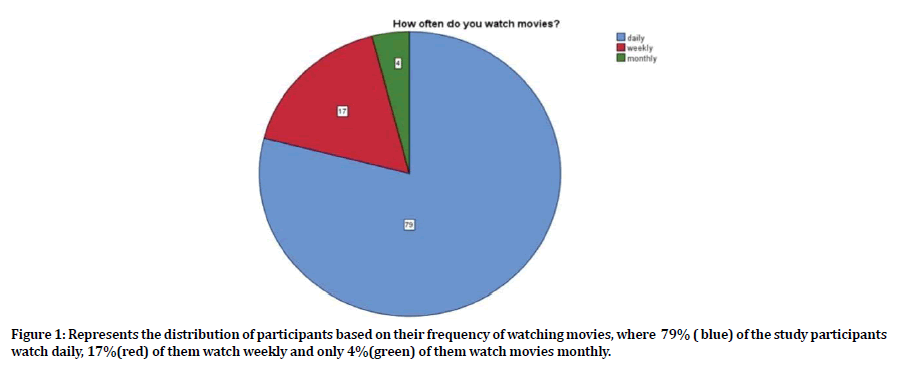
Figure 1. Represents the distribution of participants based on their frequency of watching movies, where 79% ( blue) of the study participants watch daily, 17%(red) of them watch weekly and only 4%(green) of them watch movies monthly.
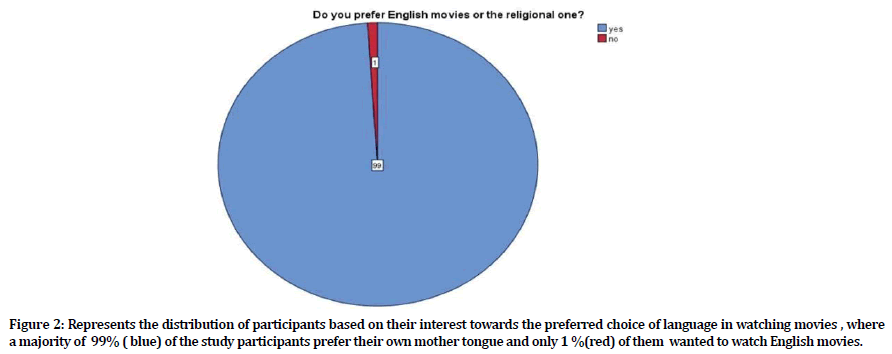
Figure 2. Represents the distribution of participants based on their interest towards the preferred choice of language in watching movies , where a majority of 99% ( blue) of the study participants prefer their own mother tongue and only 1 %(red) of them wanted to watch English movies.
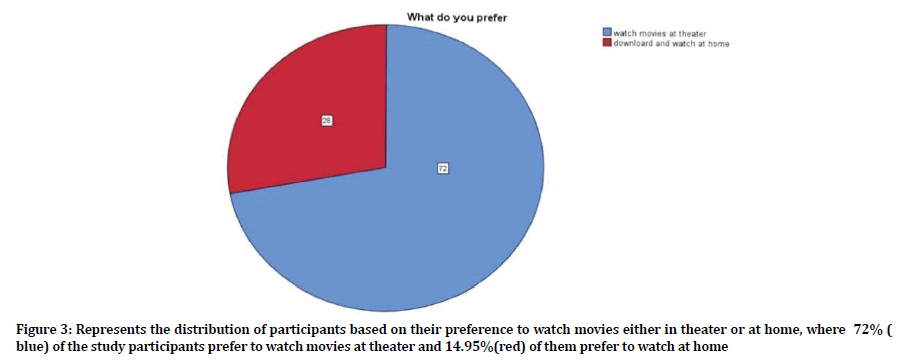
Figure 3. Represents the distribution of participants based on their preference to watch movies either in theater or at home, where 72% (blue) of the study participants prefer to watch movies at theater and 14.95%(red) of them prefer to watch at home
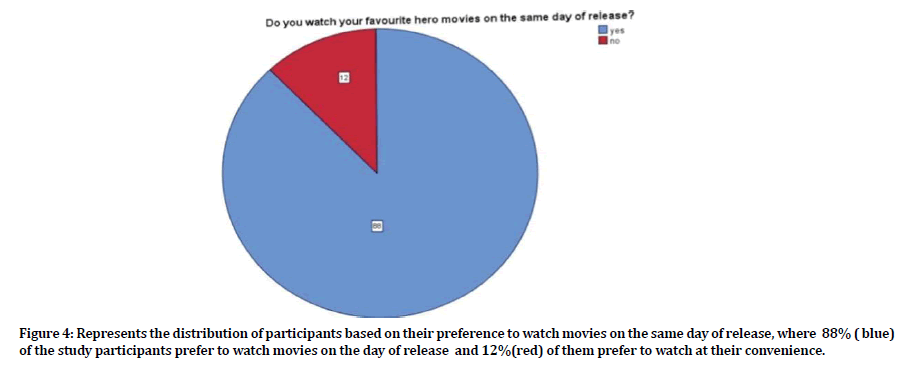
Figure 4. Represents the distribution of participants based on their preference to watch movies on the same day of release, where 88% ( blue) of the study participants prefer to watch movies on the day of release and 12%(red) of them prefer to watch at their convenience.
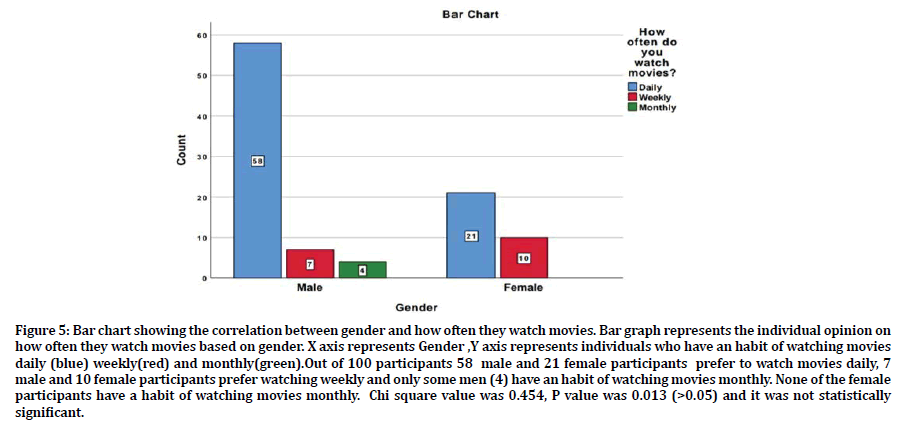
Figure 5. Bar chart showing the correlation between gender and how often they watch movies. Bar graph represents the individual opinion on how often they watch movies based on gender. X axis represents Gender ,Y axis represents individuals who have an habit of watching movies daily (blue) weekly(red) and monthly(green).Out of 100 participants 58 male and 21 female participants prefer to watch movies daily, 7 male and 10 female participants prefer watching weekly and only some men (4) have an habit of watching movies monthly. None of the female participants have a habit of watching movies monthly. Chi square value was 0.454, P value was 0.013 (>0.05) and it was not statistically significant.
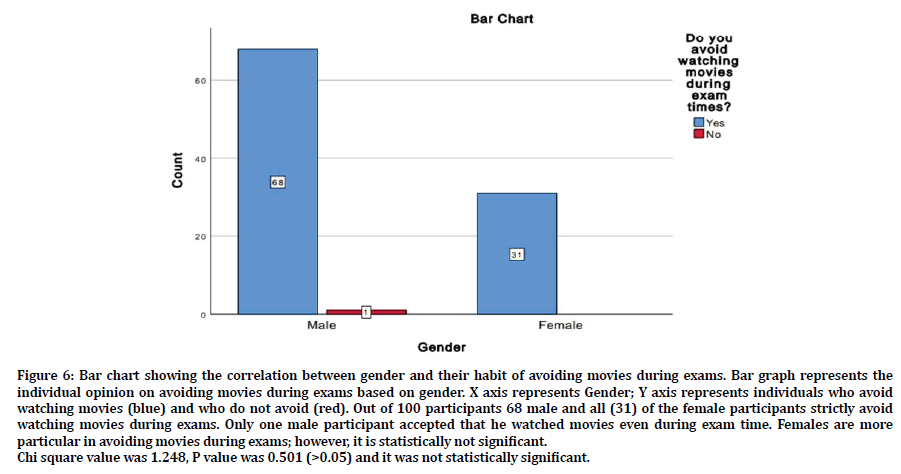
Figure 6. Bar chart showing the correlation between gender and their habit of avoiding movies during exams. Bar graph represents the individual opinion on avoiding movies during exams based on gender. X axis represents Gender; Y axis represents individuals who avoid watching movies (blue) and who do not avoid (red). Out of 100 participants 68 male and all (31) of the female participants strictly avoid watching movies during exams. Only one male participant accepted that he watched movies even during exam time. Females are more particular in avoiding movies during exams; however, it is statistically not significant. Chi square value was 1.248, P value was 0.501 (>0.05) and it was not statistically significant.
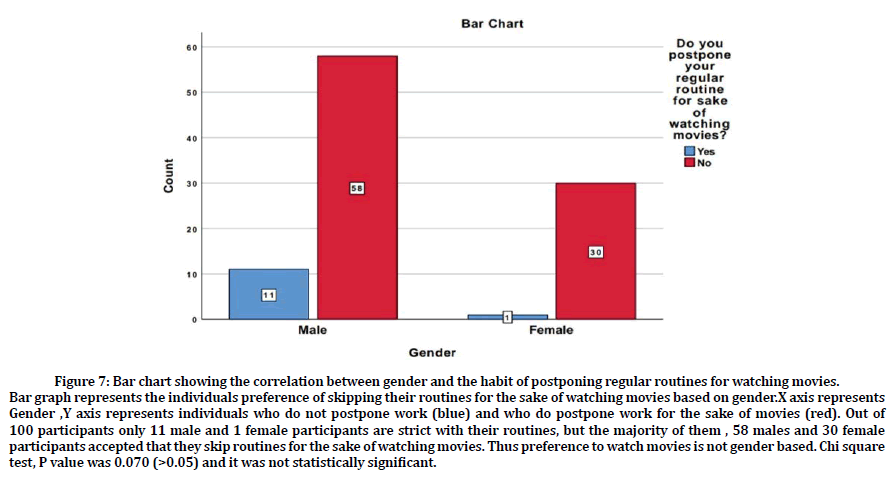
Figure 7. Bar chart showing the correlation between gender and the habit of postponing regular routines for watching movies. Bar graph represents the individuals preference of skipping their routines for the sake of watching movies based on gender.X axis represents Gender ,Y axis represents individuals who do not postpone work (blue) and who do postpone work for the sake of movies (red). Out of 100 participants only 11 male and 1 female participants are strict with their routines, but the majority of them , 58 males and 30 female participants accepted that they skip routines for the sake of watching movies. Thus preference to watch movies is not gender based. Chi square test, P value was 0.070 (>0.05) and it was not statistically significant.
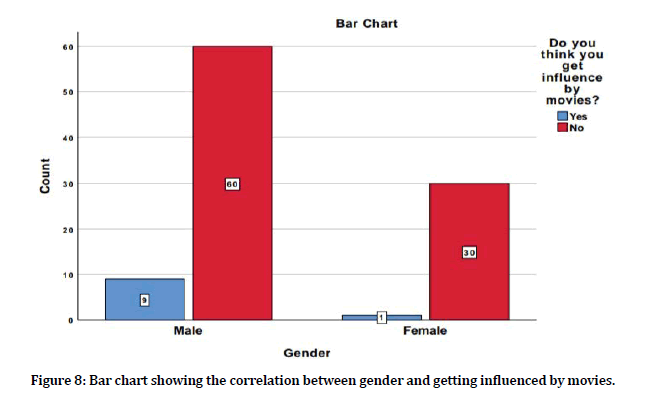
Figure 8. Bar chart showing the correlation between gender and getting influenced by movies.
When the study population is asked about the preference to watch movies at the theatre (or) download or watch at home moreover 72% of the population preferred to watch at the theatre. From that we came to know that, they like the theatre atmosphere, being like their part of life. This also proves the result made on the previous study, the impact of theatre in life [25].
In one of previous cross cultural cohort Study carried out among German students found that habit such as smoking was present upto 74% in movies and around 19% of the students started smoking by watching these movies. When compared with our study findings in the current survey, the results was similar and revealed that around 90% of the participants are influenced by many activities done in the movies [26].
The present study depicts that about 55% of the participants are used to the habit of watching movies with friends in the theatre. When compared with the previous study the results of both the study was similar that personals love watching a movie together with friends [27].
When they asked about how you watch movies. Mostly 79% responded by watch movie monthly. These results were mostly correlated with previous study about media addiction. Additions to that, when they are asked about, do you postpone the routine of your daily life to watch movies? Mostly 88% responses were no. These results depict that they are aware of movie addiction. It was further strengthened by when they are questioned about, are you aware of addiction. However 95% responses were yes.
Conclusion
The survey conducted has strengthened the fact that similar to addiction to media, movies addiction is dangerous too. Knowledge and awareness should be given to the people at the right age. From this survey, it can be concluded that urban teenagers are aware of their addiction to movies. Most of them are able to balance their routine activities along with watching their favorite movies.
References
- Ke Y, Al Aboody MS, Alturaiki W, et al. Photosynthesized gold nanoparticles from Catharanthus roseus induces caspase-mediated apoptosis in cervical cancer cells (HeLa). Artif Cells Nanomed Biotechnol 2019; 47:1938–1946.
- Li Z, Veeraraghavan VP, Mohan SK, et al. Apoptotic induction and anti-metastatic activity of eugenol encapsulated chitosan nanopolymer on rat glioma C6 cells via alleviating the MMP signaling pathway. J Photochem Photobiology 2020; 203:111773.
- Wang Y, Zhang Y, Guo Y, et al. Synthesis of zinc oxide nanoparticles from marsdenia tenacissima inhibits the cell proliferation and induces apoptosis in laryngeal cancer cells (Hep-2). J Photochem Photobiol 2019; 201:111624.
- Wu F, Zhu J, Li G, et al. Biologically synthesized green gold nanoparticles from Siberian ginseng induce growth-inhibitory effect on melanoma cells (B16). Artif Cells Nanomed Biotechnol 2019; 47:3297–3305.
- Rengasamy G, Venkataraman A, Veeraraghavan VP, et al. Cytotoxic and apoptotic potential of Myristica fragrans Houtt. (mace) extract on human oral epidermal carcinoma KB cell lines. Braz J Pharma Sci 2018; 54.
- G R, Ramya G, V VP, et al. Cytotoxicity of strawberry extract on oral cancer cell line. Asian J Pharma Clini Res 2018; 11:353.
- Ma Y, Karunakaran T, Veeraraghavan VP, et al. Sesame inhibits cell proliferation and induces apoptosis through inhibition of STAT-3 translocation in thyroid cancer cell lines (FTC-133). Biotech Bio Eng 2019; 24:646–652.
- Gan H, Zhang Y, Zhou Q, et al. Zingerone induced caspase‐dependent apoptosis in MCF‐7 cells and prevents 7, 12‐dimethylbenz(a)anthracene‐induced mammary carcinogenesis in experimental rats. J Biochem Mol Toxi 2019; 33.
- Menon A, V VP, Gayathri R, et al. Preliminary phytochemical analysis and cytotoxicity potential of pineapple extract on oral cancer cell lines. Asian J Pharma Clini Res 2016; 140.
- Jainu M, Priya V, Mohan S, et al. Biochemical evidence for the antitumor potential of Garcinia mangostana Linn. On diethylnitrosamine-induced hepatic carcinoma. Pharma Mag 2018; 14:186.
- Surapaneni KM, Vishnu Priya V, Mallika J, et al. Effect of pioglitazone, quercetin, and hydroxy citric acid on vascular endothelial growth factor messenger RNA (VEGF mRNA) expression in experimentally induced nonalcoholic steatohepatitis (NASH). Turk J Med Sci 2015; 45:542–546.
- Chen F, Tang Y, Sun Y, et al. 6-shogaol, a active constiuents of ginger prevents UVB radiation mediated inflammation and oxidative stress through modulating NrF2 signaling in human epidermal keratinocytes (HaCaT cells). J Photochemistry and Photobiology B Biology 2019; 197:111518.
- Ponnulakshmi R, Shyamaladevi B, Vijayalakshmi P, et al. In silicoandin vivoanalysis to identify the antidiabetic activity of beta sitosterol in adipose tissue of high fat diet and sucrose induced type-2 diabetic experimental rats. Toxicology Mechanisms and Methods 2019; 29:276–290.
- Rengasamy G, Jebaraj DM, Veeraraghavan VP, et al. Characterization, partial purification of alkaline protease from intestinal waste of scomberomorus guttatus and production of laundry detergent with alkaline protease additive. Ind J Pharm Edu Res 2020; 50.
- Andreassen CS, Billieux J, Griffiths MD, et al. The relationship between addictive use of social media and video games and symptoms of psychiatric disorders: A large-scale cross-sectional study. Psychology Add Behaviors 2016; 30:252–262.
- Shaw M, Black DW. Internet addiction: Definition, assessment, epidemiology and clinical management. CNS Drugs 2008; 22:353–365.
- Widyanto L, Griffiths M. “Internet Addiction”: A critical review. Int J Mental Health Addiction 2006; 4:31–51.
- Cape GS. Addiction, stigma and movies. Acta Psychiatr Scand 2003; 107:163–169.
- Griffiths M. Internet and video-game addiction. Adolescent Addiction 2008; 231–267.
- Ng BD, Wiemer-Hastings P. Addiction to the internet and online gaming. Cyberpsychol Behav 2005; 8:110–113.
- Dal Cin S, Worth KA, Dalton MA, et al. Youth exposure to alcohol use and brand appearances in popular contemporary movies. Addiction 2008; 103:1925–1932.
- Young KS. Internet addiction: Evaluation and treatment. BMJ. 1999; 319:9910351.
- Shukri NMM, Vishnupriya V, Gayathri R, et al. Awareness in childhood obesity. Research J Pharm Tech 2016; 9:1658.
- Witham B. Theater, environment, and the thirties. Readings in Performance and Ecology 2012; 13–22.
- Walmsley B. “A big part of my life”: A qualitative study of the impact of theatre. Arts Marketing: An Intern J 2013; 3:73–87.
- Hanewinkel R, Sargent JD. Exposure to smoking in popular contemporary movies and youth smoking in Germany. Am J Prev Med 2007; 32:466–473?
- Wong ACS, Grove AE, Lee EM, et al. System and method for interactive remote movie watching, scheduling, and social connection. Patent 8990303, 2015.
Author Info
Subaraman M, Gayathri R*, V Vishnu Priya and S Kavitha
Departments of Biochemistry, Saveetha Dental College and Hospitals, Saveetha Institute of Medical and Technical Sciences (SIMATS), Saveetha University Tamilnadu, IndiaCitation: Subaraman M, Priya VV, Kavitha S, Gayathri R, Knowledge awareness and perception on the addiction to movies among urban teenagers a survey, J Res Med Dent Sci, 2021, 9 (2):364-369.
Received: 23-Sep-2020 Accepted: 22-Feb-2021
